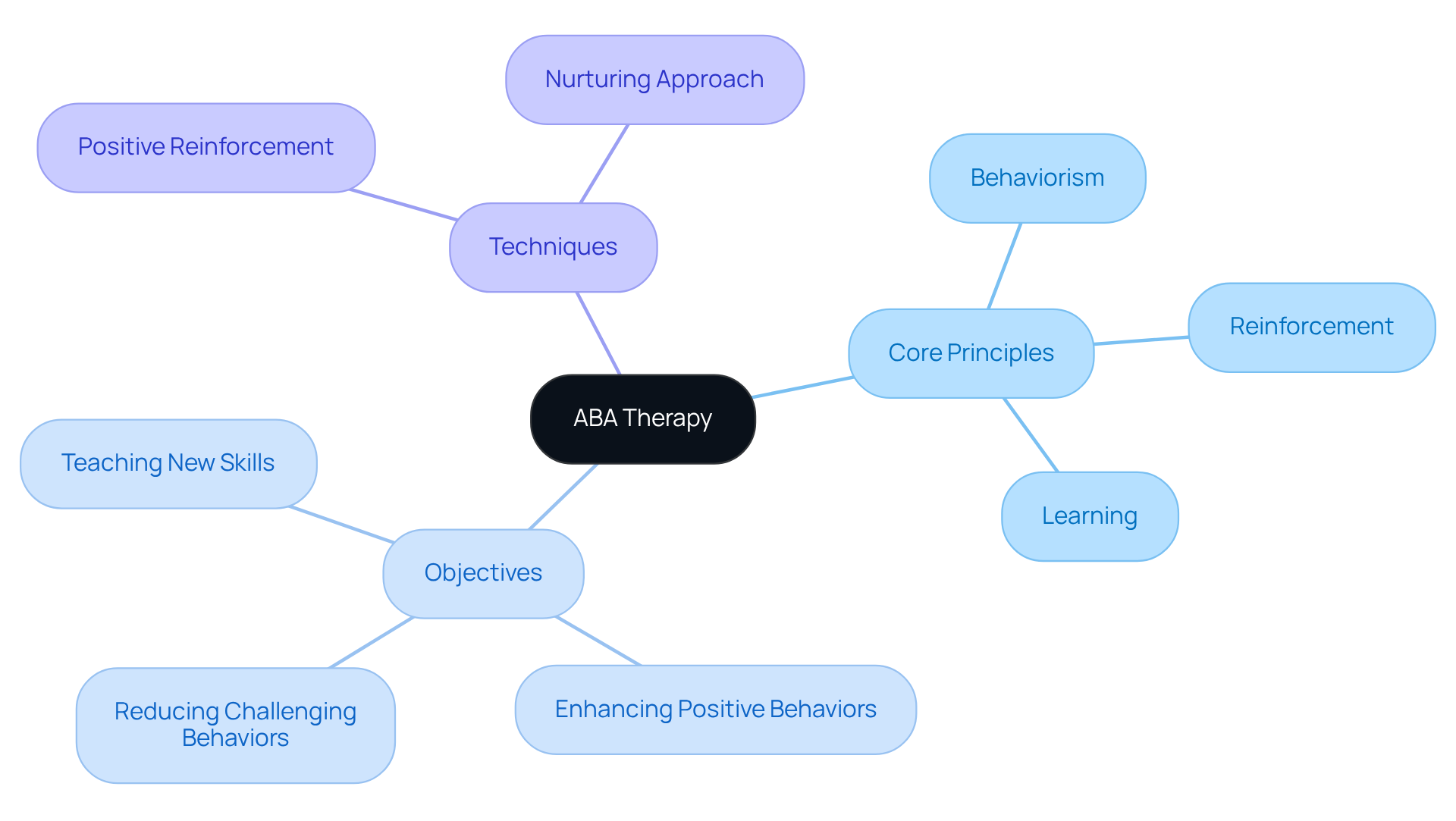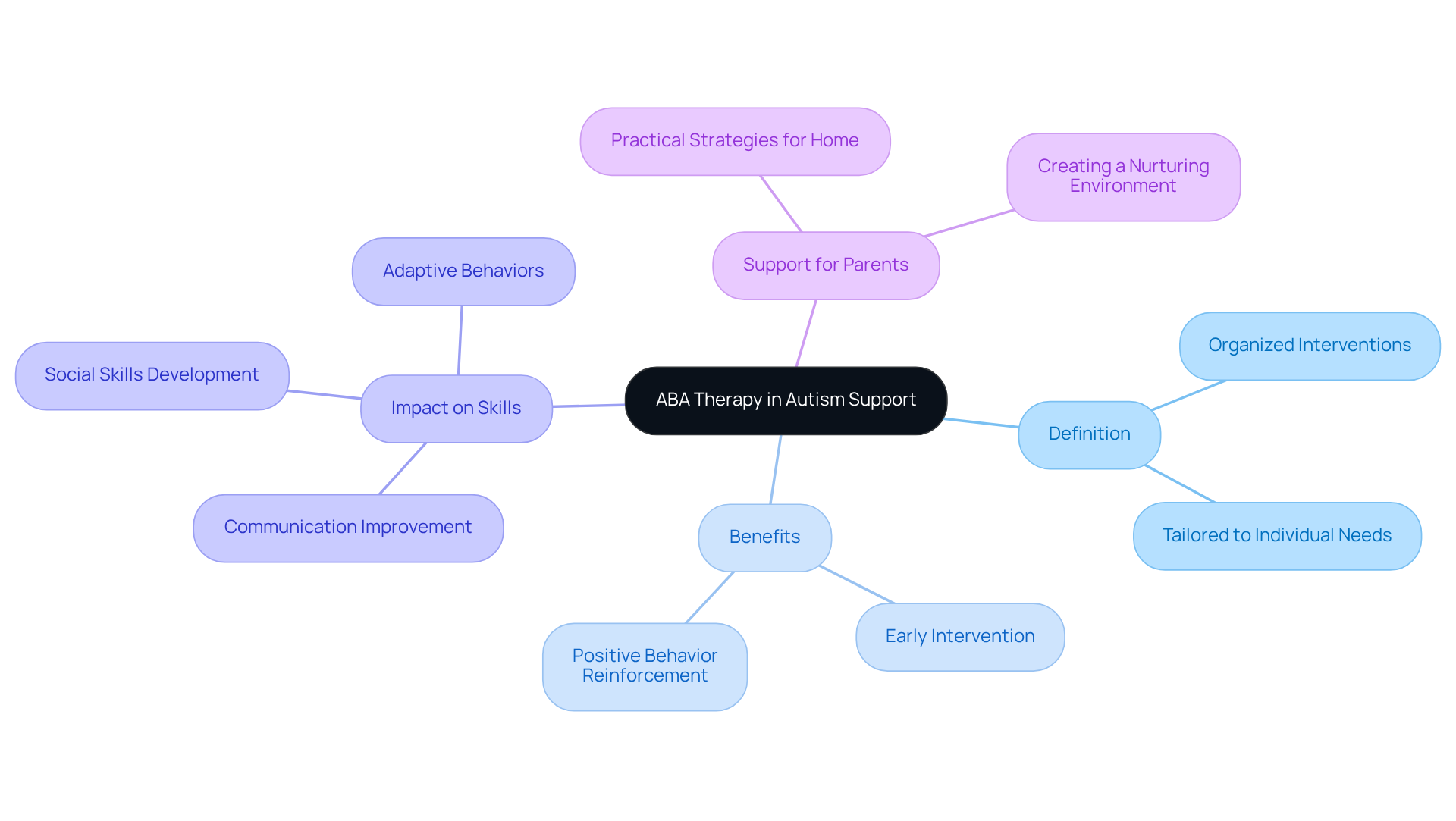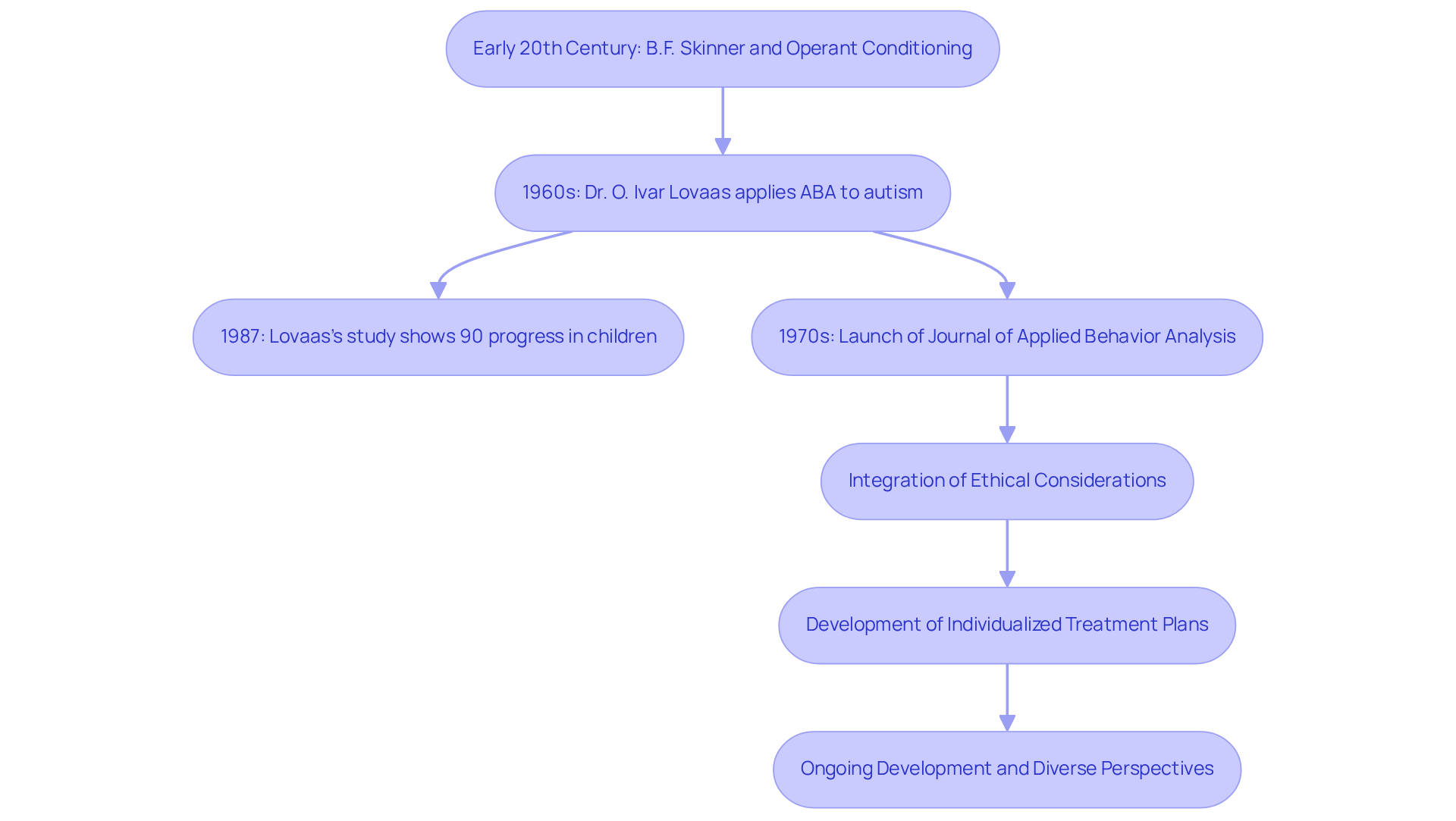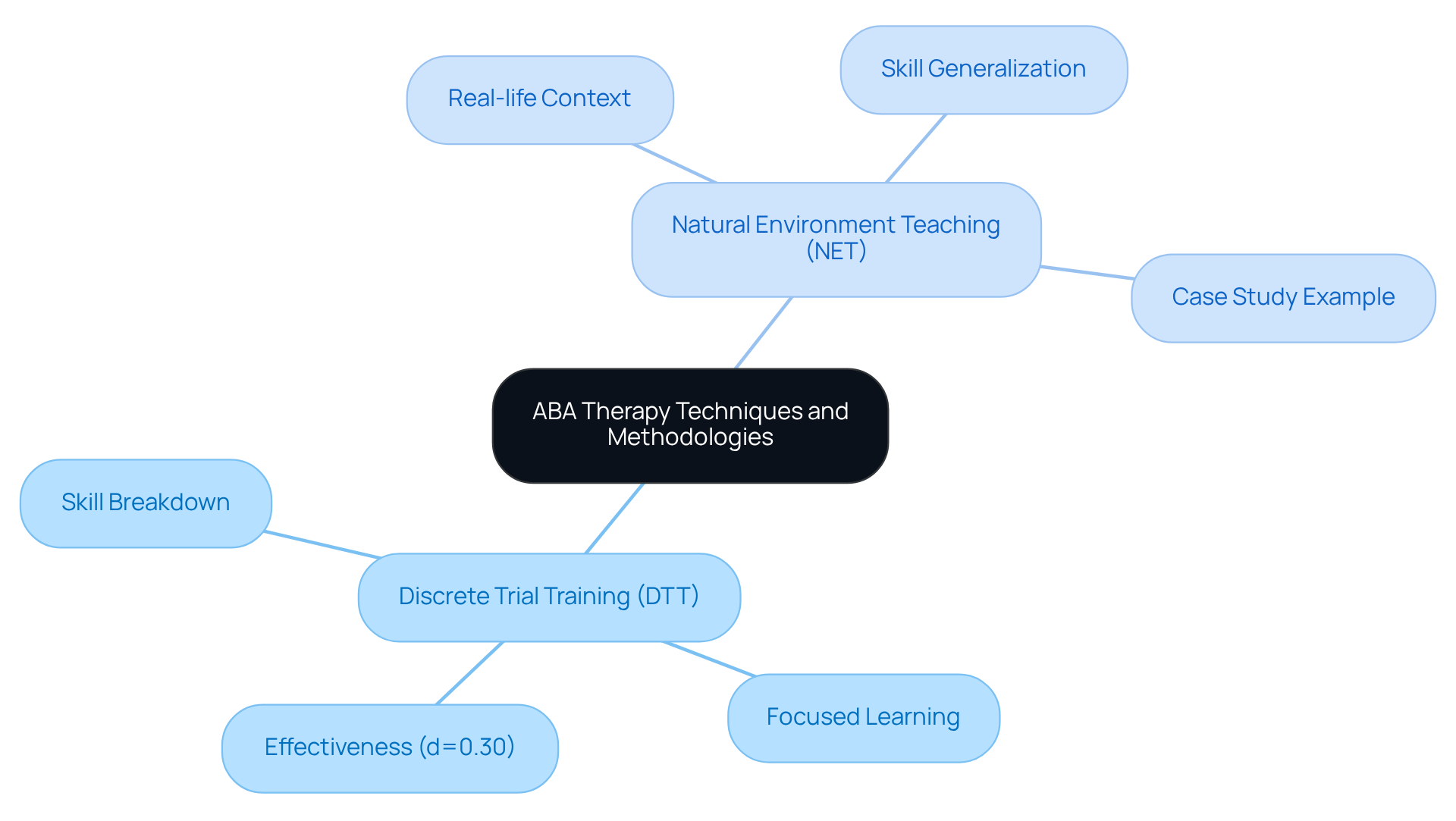Overview
ABA therapy, or Applied Behavior Analysis, is a vital lifeline for families navigating the challenges of autism. It not only enhances positive behaviors but also teaches essential new skills and helps reduce challenging behaviors through structured interventions. Research consistently supports the effectiveness of ABA therapy, revealing significant improvements in communication and social skills. When tailored to meet the unique needs of each individual, it becomes an invaluable resource for families seeking support.
For many parents, understanding the nuances of ABA therapy can feel overwhelming. However, knowing that there are proven methods to foster growth and development brings hope. Imagine witnessing your child communicate more effectively or engage socially with peers—these are the transformative outcomes that ABA therapy can facilitate.
As you explore options for autism support, consider the profound impact that personalized ABA therapy can have on your child's journey. It's not just about addressing behaviors; it's about nurturing potential and building connections. Reach out to professionals who can guide you in finding the right approach tailored specifically for your child’s needs. Together, we can pave the way toward a brighter future.
Introduction
Navigating the complexities of autism support can feel overwhelming for many families, especially when faced with the myriad of therapeutic options available. Among these, Applied Behavior Analysis (ABA) therapy emerges as a structured and effective intervention that has positively impacted the lives of countless individuals on the autism spectrum.
As families seek to understand how ABA therapy can enhance communication, foster social skills, and promote independence, it’s natural for questions to arise about its core principles and methodologies.
What makes ABA therapy a vital resource in autism support, and how can it be personalized to address the unique needs of each individual?
Define ABA Therapy: Core Principles and Objectives
What's ABA therapy is an intervention that offers a compassionate approach to understanding and changing behaviors. Grounded in the principles of behaviorism, it emphasizes that our actions can be learned or unlearned through the power of reinforcement and outcomes. For many parents, understanding what's ABA therapy helps clarify their main goals: enhancing positive behaviors, teaching new skills, and reducing challenging behaviors that may interfere with daily life. Techniques like positive reinforcement, where we celebrate and reward desirable actions, are at the heart of this nurturing approach.
What's ABA therapy is widely recognized for its significant impact on individuals with autism spectrum disorder (ASD). It plays a vital role in improving communication, fostering social skills, and promoting independence. As you explore this journey, know that support is available, and many families have found hope and progress through these methods. If you’re curious about what's ABA therapy and how it can positively impact your loved one’s life, consider reaching out to professionals who can guide you through the process.

Contextualize ABA Therapy: Importance in Autism Support
What's ABA therapy is that it holds a special place in autism assistance, offering organized interventions tailored to the unique needs of individuals with ASD. Research has shown that early intervention using what's ABA therapy can lead to remarkable improvements in communication, social skills, and adaptive behaviors. What's ABA therapy focuses on observable actions and employs data-informed strategies to help individuals with autism navigate social interactions and daily tasks more effectively.
Moreover, it equips parents and caregivers with practical strategies to reinforce positive behaviors at home, creating a nurturing environment that fosters growth and development. Imagine the peace of mind that comes from knowing you have the tools to support your child’s journey. Together, we can make a difference in their lives, encouraging every step of their progress.

Trace the Evolution of ABA Therapy: Historical Development and Milestones
The journey of what's ABA therapy began in the early 20th century, influenced by important behaviorists like B.F. Skinner, who introduced the concept of operant conditioning. However, it was Dr. O. Ivar Lovaas in the 1960s who truly transformed the field by applying what’s ABA therapy principles to support youth with autism. His groundbreaking study revealed that intensive behavioral interventions could lead to remarkable improvements in communication, social skills, and overall quality of life for individuals with autism spectrum disorder (ASD). In fact, Lovaas's research from 1987 showed that nearly 90% of children receiving what's ABA therapy experienced significant progress, which solidified its reputation as a leading intervention for autism.
As the years have passed, ABA practices have evolved significantly, adapting to include ethical considerations and a stronger focus on individualized treatment plans tailored to each child's unique needs. Key milestones in this evolution include the launch of the Journal of Applied Behavior Analysis in the 1970s, which served as an important platform for sharing research and best practices within the field. Additionally, various ABA methods, such as Discrete Trial Training (DTT), have become integral to clinical practice, demonstrating the effectiveness of structured interventions in shaping behaviors.
The ongoing development of ABA reflects a deep commitment to enhancing therapeutic practices while respecting the unique identities of autistic individuals. While some critics have raised concerns about historical ABA methods, it is essential to integrate diverse perspectives and methodologies to better serve individuals on the autism spectrum. As the field continues to grow, embracing these considerations will be vital in fostering independence and self-advocacy skills among autistic individuals.
We invite parents and caregivers to share their experiences and thoughts on ABA practices, as your insights can help shape a more inclusive and supportive environment for all.

Explore Key Characteristics: Techniques and Methodologies in ABA Therapy
What's ABA therapy includes a variety of methods thoughtfully designed to positively influence behaviors. Among the most recognized approaches are Discrete Trial Training (DTT) and Natural Environment Teaching (NET). DTT breaks down skills into small, manageable components, allowing for focused learning and mastery of each step. This structured method has shown considerable effectiveness; research indicates that individuals participating in DTT can achieve significant improvements in communication and social skills, with a standardized mean difference for communication results noted as d=0.30. As we look to 2025, DTT remains valued for its systematic approach, facilitating skill acquisition through repetition and reinforcement.
On the other hand, NET focuses on teaching within real-life contexts, making learning more relevant and applicable to everyday situations. Evidence supports that young participants in NET demonstrate improved generalization of skills, leading to enhanced social interactions and adaptive behaviors. For example, a case study illustrated a young individual who, through NET, learned to initiate conversations with peers during playtime, highlighting the practical benefits of this approach. ASD Media notes, 'the information that led them to this was presented as moderate evidence, but it still demonstrates what's ABA therapy can be effective for the typical youth,' reinforcing the value of NET.
Moreover, essential techniques like prompting, modeling, and reinforcement are vital to the ABA framework. These strategies are tailored to meet the unique needs of each individual, ensuring that interventions are both effective and relevant. Insights from ABA practitioners underline the significance of these methodologies in promoting meaningful progress for children with autism. As the field advances, the integration of these techniques continues to play a crucial role in enhancing what's ABA therapy all about.

Conclusion
Understanding the essence of ABA therapy illuminates its vital role in supporting individuals with autism spectrum disorder (ASD) through structured and compassionate interventions. This therapy goes beyond merely modifying behaviors; it emphasizes the development of essential life skills, enhances communication, and fosters independence. By recognizing the significance of ABA therapy, families can find hope and direction as they navigate the challenges associated with autism.
The article highlights key insights, including the foundational principles of ABA therapy, its historical evolution, and the various methodologies employed to create effective interventions. Techniques such as Discrete Trial Training (DTT) and Natural Environment Teaching (NET) have shown substantial benefits, enabling individuals with autism to improve their social interactions and adaptive skills. The ongoing commitment to ethical practices and individualized treatment plans underscores the importance of tailoring approaches to meet the unique needs of each person.
Reflecting on the impact of ABA therapy, it is crucial to recognize its potential to transform lives. Parents and caregivers are encouraged to engage with professionals and share their experiences. This collaboration can foster a more inclusive and supportive environment for individuals with autism. Embracing the principles of ABA therapy not only promotes positive behavior change but also empowers individuals to thrive in their communities. Together, let’s create a brighter future for those we care about.
Frequently Asked Questions
What is ABA therapy?
ABA therapy, or Applied Behavior Analysis therapy, is an intervention that focuses on understanding and changing behaviors through a compassionate approach. It is grounded in behaviorism principles, emphasizing that actions can be learned or unlearned through reinforcement and outcomes.
What are the main goals of ABA therapy?
The main goals of ABA therapy include enhancing positive behaviors, teaching new skills, and reducing challenging behaviors that may interfere with daily life.
What techniques are commonly used in ABA therapy?
Common techniques in ABA therapy include positive reinforcement, where desirable actions are celebrated and rewarded, forming a nurturing approach to behavior change.
Who benefits from ABA therapy?
ABA therapy is widely recognized for its significant impact on individuals with autism spectrum disorder (ASD), helping to improve communication, foster social skills, and promote independence.
How can families find support for ABA therapy?
Families seeking support for ABA therapy can reach out to professionals who can guide them through the process and provide assistance for their loved ones.




